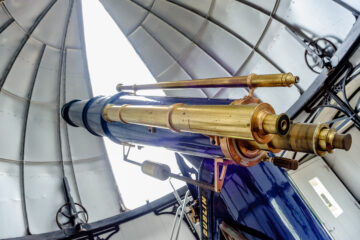RECORD-BREAKING MAY 2020: WARMER AND SUNNIER THAN AVERAGE, DRIEST AT ARMAGH FOR 29 YEARS. SUNNIEST SPRING FOR AT LEAST 140 YEARS AND DRIEST AT ARMAGH SINCE 1870.
Armagh Observatory reports that May 2020 was warmer, sunnier and much drier than average. The meteorological spring (March, April and May) was the sunniest on record at Armagh, and the driest since 1870, that is, for 150 years.
Total precipitation was 17.8 mm (0.70 inches), including 4 trace values (i.e. 17.6 mm if trace values are ignored). This is approximately 30% of the average May precipitation at Armagh. The wettest day was the 21st with 6.6 mm (0.26 inches) of rainfall, followed by the 1st with 2.7 mm. This was the 13th driest May on record at Armagh, that is, since daily measurements of precipitation began in 1838, and the driest May at Armagh for 29 years, that is, since 1991 (6.5 mm).
The spell of largely warm, dry weather was interrupted by a couple of days of strong wind on the 22nd and 23rd. The wind was associated with a deep depression in the Atlantic Ocean, which unusually produced gale-force winds over Northern Ireland on the 22nd but relatively little precipitation.
The mean monthly temperature was approximately 12.34 degrees Celsius (54.2 Fahrenheit), 1.77 C warmer than the long-term (1796–2010) average May temperature at Armagh and nearly 1.18 C warmer than the most recent (1981–2010) 30-year May average. This was the warmest May at Armagh for two years, that is, since May 2018 (mean temperature 12.89 C), and the 15th-warmest May on record at Armagh since records began at the end of 1794.
The warmest day (highest maximum air temperature) was 25.1 C on the 28th. This was the warmest May day at Armagh for three years and the warmest day of the year at Armagh up to the end of May. It was also the eighth-warmest May day on record at Armagh, that is, since daily records of maximum and minimum temperatures began at Armagh in August 1843. This very warm 28th May was followed by 23.8 C on the 30th and 23.5 C on the 31st. By contrast, the coolest day (lowest maximum air temperature) was 11.4 C on the 10th, followed by 11.5 C on the 11th.
The warmest night (highest minimum temperature over the previous 24 hours) was 12.6 C recorded on the 19th, followed by 11.2 C on the 18th. There were several very cool nights, the coldest of which, representing the lowest minimum temperature over the previous 24 hours, was -0.8 C recorded on the 14th. This lowest minimum temperature on the 14th was preceded by -0.4 C recorded on the 11th, and 1.8 C and 1.9 C on the 12th and 13th May respectively. The 14th was the coolest May night recorded at Armagh for five years, that is, since a lowest minimum temperature of -1.5 C was recorded on 2015 May 1.
There were 13 nights with ground frost (grass temperature less than or equal to zero), the coldest three of which were -10.1 C on the 14th, -9.6 C on the 11th and -7.8 C on the 12th. There were two air frosts (the two minimum air temperatures recorded on the 14th and 11th). There was a total of 224.9 hours of strong sunshine, which is nearly 20% more than the long-term (1881–2010) average number of hours of strong sunshine at Armagh and nearly 30% more than the most recent (1981–2010) 30-year average (173.28 hours). The sunniest day was the 11th, with 15.0 hours of strong sunshine, followed by the 6th and 26th with 14.6 and 14.5 hours respectively. This was the sunniest May at Armagh for three years, that is, since the exceptionally sunny May 2017 (250.2 hours of strong sunshine), and the 17th sunniest May on record at Armagh, since observations of daily sunshine hours began at Armagh in April 1880.
Taking the meteorological spring March, April and May together, spring 2020 was the sunniest on record at Armagh, warmer and much drier than average.
The average spring temperature was 9.67 C, nearly 1.65 C warmer than the long-term (1796–2010) average spring temperature at Armagh and 0.91 C warmer than the most recent (1981–2010) 30-year average. This was the tenth-warmest sprint on record at Armagh and the warmest for three years, that is, since the exceptionally warm spring 2017 (mean temperature 10.19 C).
Total precipitation was 79.2 mm including 8 trace values (78.8 mm if trace values are ignored), which is less than half (approximately 47%) of the long-term (1838–2010) spring precipitation at Armagh and 44% of the most recent (1981–2010) 30-year average. This was the third-driest spring on record at Armagh and the driest for 150 years, that is, since spring 1870. The five driest springs at Armagh are now: 1870 (43.3 mm), 1844 (56.4 mm), 2020 (79.2 mm), 1946 (71.8 mm) and 1875 (74.6 mm).
It is interesting to note that this very dry spring 2020 followed the rather wet winter 2019/2020. Although December 2019 was slightly drier than average and January 2020 much drier, February 2020 was very wet (the second wettest February on record at Armagh), which led to winter 2019/2020 at Armagh being rather wetter than average.
There has been much media and professional commentary on the significance of this swing in total rainfall between two successive seasons. At Armagh, the difference in total rainfall between winter 2019/2020 and spring 2020 was 182.1 mm, but this is dwarfed by examples such as the difference (246.0 mm) in the amount between winter 1914/1915 and spring 1915, and by the difference (241.2 mm) between winter 2015/2016 and spring 2016.
There are other examples, and of course cases where the reverse occurs, that is, a dry winter followed by an unusually wet spring. Evidently, rainfall fluctuates a lot, both locally and regionally, and different datasets differ one from another. At Armagh, and possibly elsewhere, the rule of thumb is that whereas the quantity of rainfall fluctuates a lot from day to day, month to month and year to year, in the medium to long term such variations largely cancel out and there is little or no significant long-term trend in precipitation.
In contrast to the prior year (spring 2019), which registered an unusually small number of hours of strong sunshine, spring 2020 was exceptionally sunny. At Armagh, each of the spring months March, April and May were sunnier than average, and these combined to give a total of 567.4 hours of strong sunshine. This year was the sunniest spring on record at Armagh, that is, since sunshine records began 140 years ago in April 1880. The total spring sunshine was 24% more than the long-term (1881–2010) average at Armagh and 37% more than the most recent (1981–2010) 30-year average. The five sunniest springs on record at Armagh are now: 2020 (567.4 hours), 2007 (554.3 hours), 2008 (547.6 hours), 1962 (533 hours) and 1905 (523.4 hours).
These data refer to observations at Armagh Observatory, which has been recording the weather at Armagh since 1795.
FOR FURTHER INFORMATION PLEASE CONTACT: Mark Bailey at the Armagh Observatory, College Hill, Armagh, BT61 9DG. Tel.: 028-3752-2928; FAX: 028-37527174; mark.bailey@armagh.ac.uk; URL: http://climate.armagh.ac.uk/.



0 Comments